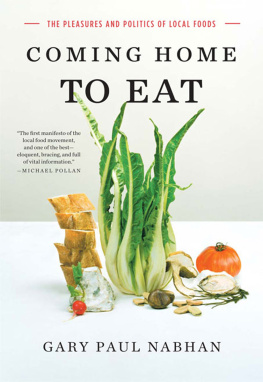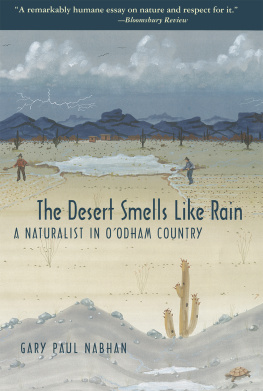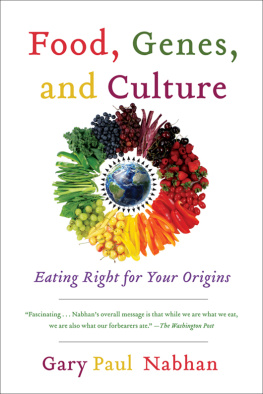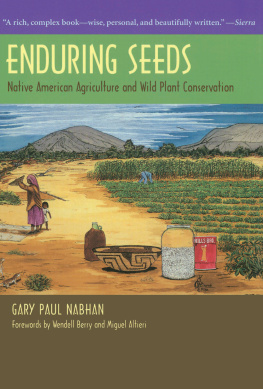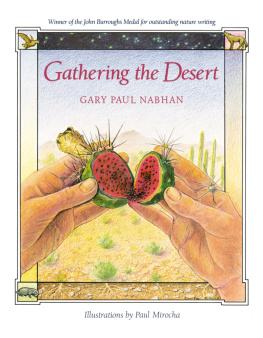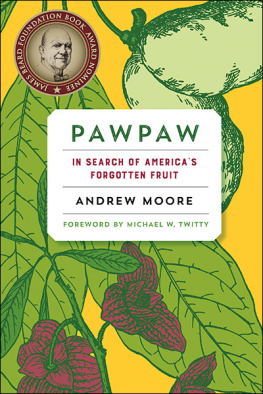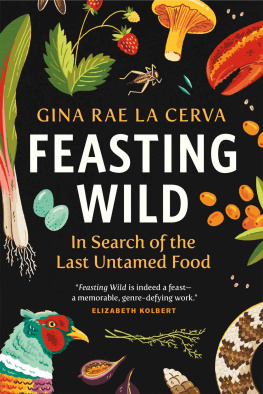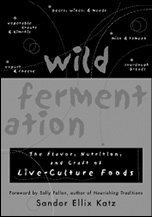More praise for
Coming Home to Eat
Nabhan explores the seasonal resources of his regional food shed in an attempt to understand the full meaning of eating well. Indulging a joyful taste for wild foodleads him to an enriched sense of community and to better ways of eating that are delicious to the palate and easy on the land. This timely and thoughtful book suggests a different path toward health and responsible living.
Audobon
A practical primer on how to eat locally, think globally (and to enjoy it more) wherever you are. Nabhan explores one of the greatest sources of global despoliation and tells us exactly what we can do about it: eat consciously, and eat foods grown close at hand.
Stanley Crawford, author of A Garlic Testament: Seasons on a Small New Mexico Farm
Weaving together the traditions of Thoreau and M. F. K. Fisher, Nabhan challenges the wisdom of buying into the planetary supermarket and offers his personal journey to eat locally as an alternative. A rare combination of the sensual and the intellectual, Coming Home to Eat is a soul food treatise for our time.
Peter Hoffman, chef-owner of Savoy Restaurant in New York City and national chair of Chefs Collaborative
A tale certain to inspire gardeners, cooks, and others eager to replace convenience with flavor.
Country Living Gardener
A profound and engaging book, a passionate call to us to rethink our food industry and to return when possible to our own locale for the sources of what we cook and eat.
Jim Harrison, author of The Beast God Forgot to Invent
Dr. Nabhans adventures with food wove through my day. [A] good book for gardeners to read this winter, as they dream of what to order from that avalanche of catalogs [and] a reasoned primer on the risks of bioengineered crops.
Anne Raver, New York Times
Nabhan is a brilliant scientist (ethnobotany) and remarkably successful social activist. In Coming Home to Eat he weaves ideas about eating right into his interest in the pleasure of caring for ecosystems and communities. His stories are often funny and always invaluable.
William Kittredge, author of The Nature of Generosity
[Nabhan] writes with a passion for those of us who still see and trust the wild in our land. His stories celebrate the sense of place that belongs in all our foods.
David Mas Masumuto, organic farmer and author of Epitaph for a Peach and Harvest Son
[A] global meditation on finding sustenance in your own backyard.
Tucson Weekly
A purist at heart, Nabhan questions the world-at-your-fingertips approach to eating adopted by many Americans. [His] narrative will change the way that readers look at their meals forever.
Natural Home
This book is about communion. It describes a sacred relationship to food and place. The author celebrates the sensual pleasures of food while giving the reader an education about global food politics in a savory blend of personal story, research, and reflection, all served up in delicious prose.
Earthlight
An eloquent and trailblazing writer. Warmhearted, innovative, and respectful of life, Nabhan inspires readers to think twice about corporate domination of the food supply and the old adage You Are What You Eat.
Booklist
Coming Home to Eat
Also by Gary Paul Nabhan
Where Our Food Comes From:
Retracing Nikolay Vavilovs Quest to End Famine
Renewing Americas Food Traditions:
Saving and Savoring the Continents Most Endangered Foods (editor)
Arab/American: Landscape, Culture, and Cuisine in Two Great Deserts
Renewing Salmon Nations Food Traditions (editor)
Why Some Like It Hot: Food, Genes and Cultural Diversity
Woodlands in Crisis (with Marcelle Coder and Susan J. Smith)
Cross-Pollinations: The Marriage of Science and Poetry ( ESSAYS )
Tequila! A Natural and Cultural History (with Ana G. Valenzuela-Zapata)
Singing the Turtles to Sea
Efran of the Sonoran Desert: A Lizards Life Among the Seri Indians (with Amalia Astorga and Janet K. Miller)
La Vida Nortea (with David Burckhalter and Thomas E. Sheridan)
People, Plants and Protected Areas (with John Tuxill)
Creatures of Habitat ( POEMS )
Cultures of Habitat ( COLLECTED ESSAYS )
The Forgotten Pollinators (with Stephen Buchmann)
Canyons of Color (with Caroline Wilson)
The Geography of Childhood (with Stephen Trimble)
Songbirds, Truffles and Wolves
Counting Sheep: Twenty Ways of Seeing Desert Bighorn (editor)
Desert Legends (photos by Mark Klett)
Enduring Seeds ( ESSAYS )
Gathering the Desert (drawings by Paul Mirocha)
The Desert Smells Like Rain

Coming Home to Eat
The Pleasures and Politics of Local Foods
Gary Paul Nabhan, Ph.D.

W. W. NORTON & COMPANY
NEW YORK LONDON
Copyright 2002 by Gary Paul Nabhan
All rights reserved
For information about permission to reproduce selections from this book, write to Permissions, W. W. Norton & Company, Inc.,
500 Fifth Avenue, New York, NY 10110
Drawings by Hannah Hinchman
Library of Congress has cataloged the hardcover edition as follows:
Nabhan, Gary Paul.
Coming home to eat: the pleasures and politics of local foods / Gary Paul Nabhan.
p. cm.
Includes bibliographical references.
ISBN: 978-0-393-07549-6
1. Gastronomy.I. Title.
TX631 .N33 2001
641.013dc21 2001034556
W. W. Norton & Company, Inc.
500 Fifth Avenue, New York, N.Y. 10110
www.wwnorton.com
W. W. Norton & Company Ltd.
Castle House, 75/76 Wells Street, London W1T 3QT
For my wife, Laurie;
my brothers, Norm and Doug;
and my mother Jerri, the hearth for us all
The whole of nature is a conjugation
of the verb to eat , in the active
and in the passive.
W ILLIAM R. I NGE , Outspoken Essays , First Series
Nature is a damp place
over which large numbers
of ducks fly, uncooked.
O SCAR W ILDE
Contents
Preface and Acknowledgments
T his book is about a year of eating locally, a year that also happened to be a watershed in the history of global food politics. It is the story of finding kindred food-loving souls within a 250-mile radius of my home in Arizona, and sharing with them the pleasures of gardening and gathering, pit roasting and fermenting, feasting and frolicking. But it is also a book of juxtapositions: about how the remaining farmers, fishermen, and foragers within my foodshed struggle with challenges, insults, and absurdities different from the ones their ancestors faced a century ago. Wherever I foraged with my neighbors for wild greens, hunted for quail, or sowed heirloom crops, we have seldom been out of earshot of the global vending machine. It can still be heard dropping its hermetically sealed packages of textured soy protein, genetically engineered tortillas, and artificial spices no matter how hard you or I try to get away from its noise.
Fortunately, I am not the only one wondering what kinds of ancient culinary melodies are being drowned out by the noise of that transnational vending machine. One defining momentthe equivalent of a Boston Tea Partycan fittingly be said to have taken place at the turn of the twenty-first century. Farmers refused to grow certain patented seeds foisted upon them by transnational corporations, and students destroyed experimental fields and labs where genetically engineered crops were being developed. Consumers demanded that the contents of foods be labeled on their packages, and boycotted companies whose advertising was deceptive. Mobs attacked McDonalds and Starbucks as part of the protests against the annual meeting of the World Trade Organization in Seattle. Groups in other countries fought against the corporate control of farmlands, seeds, and genes, and banned U.S. agricultural products potentially harmful to butterflies and babies. The launching of the Slow Food Movement in the United States made me aware that there are at least 100,000 like-minded souls in Europe and Latin America. This book celebrates the sensual pleasures of food without ignoring its global politics, for we will hardly be able to savor such pleasures any longer if we do not decide how to disconnect that omnipresent vending machine.

